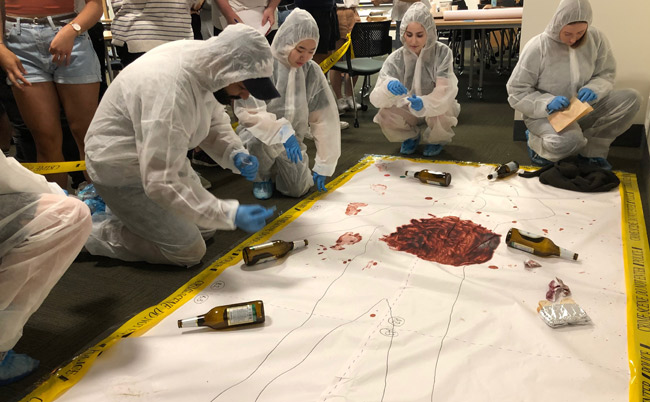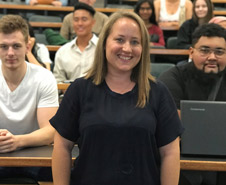Wednesday 20 February 2019 10:27pm

Students in this year’s Introduction to Forensic Biology paper search a ‘crime scene’ for clues.

Dr Angela Clark.
Blood spatter, fingerprinting, bite marks, and DNA analysis. They’re the stuff of TV CSI crime shows but they’re also standard fare in one of the most enduringly popular papers offered in the University of Otago’s Summer School.
FORB201 Introduction to Forensic Biology, is run by the Sir John Walsh Research Institute, Faculty of Dentistry, and has attracted more than 1,300 students in the last 12 years.
Forensic anthropologist, Dr Angela Clark, who has taught and coordinated the paper since 2015, says the students learn how to become “forensic-thinkers”.
“They get the opportunity to act-out the role of a CSI investigator and examine a mock crime scene.
“On top of that, a series of guest lecturers are brought into the classroom so that students are able to hear from expert forensic scientists about real casework.”
This year’s guests included world-renowned Thai forensic pathologist and medical doctor, Dr Khunying Porntip Rojanasunan, forensic experts from the New Zealand Police and ESR, University of Otago academic staff and independent forensic practitioners.
Dr Clark says guest lecturers are able to give the students the benefit of their case experience.
"It gives students an introduction to applied science and scientific methods which is very useful."
“They talk about the specific cases they’ve worked on and how their forensic expertise in a particular area has helped solve that case.
“So then the students can apply that knowlege towards solving their own case.”
In addition to providing an overview of the multidisciplinary nature of forensic science, the paper is also designed to give students an understanding of some of the associated contemporary issues, such as bias and the so-called “CSI-Effect”.
Dr Clark says the issues of contextual and cognitive bias are a significant factor in solving the practical ‘who-dunnit’ component of the paper.
“Bias is all around us and forensic experts have to be aware of it,” she says. “The students have to acknowledge their own biases, something that is increasingly common in forensic science, and by being aware of their biases try not to fall under their influence but take measures to counteract these.”
The Director of Summer School, Dr Elaine Webster says Introduction to Forensic Biology is consistently either the biggest or second biggest class in Summer School.
Dr Webster says Summer School students are often looking to broaden their degree by studying a paper that interests them and trying something new.
“It gives students an introduction to applied science and scientific methods which is very useful.”
The paper was originally developed by the late Professor Jules Kieser from the Faculty of Dentistry and was first offered in 2008.
